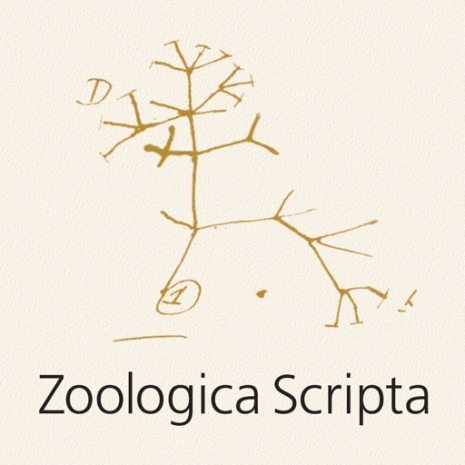
The Role of Systematics for Understanding Ecosystem Functions
The scheduled Zoologica Scripta symposium will offer a forum for exploring trends and future developments in the field of systematics. We have invited leading experts in the field and compiled an attractive programme to address and discuss with you the imminent issues of animal systematics.
Many biologists are concerned about the taxonomic impediment and the decline of expertise in taxonomy and systematics; even more so in the context of ongoing biodiversity loss and climate change. At the same time, we experience an upgrading of the portfolio of methods to highly advanced and complex 'big data' analyses, and a frequently heard expectation is that this will further increase the taxonomic and systematics knowledge gap. The trends towards more complex analyses as well as understanding systematics in an ecological context is also reflected in the manuscripts submitted to the Zoologica Scripta.
The taxonomic impediment is not only a scientific issue but also of importance for societal development. Roughly ten years ago the Intergovernmental Science-Policy Platform for Biodiversity and Ecosystem Services (IPBES) was established, aiming, among others, at advancing knowledge and data as well as at building capacities that strengthen the science-policy interface for biodiversity and ecosystem services for the conservation and sustainable use of biodiversity.
Per Sundberg (chief editor), Per Ericson and Lutz Bachmann (executive editors)
The Norwegian Academy of Science and Letters and the editors of the Zoologica Scripta invite to an international one-day symposium on 'The role of systematics for understanding ecosystem functions'
The Zoologica Scripta, published on behalf of The Norwegian Academy of Science and Letters and The Royal Swedish Academy of Sciences, is one of the leading scientific journals in the fields of animal systematics, phylogeny, and biogeography. The journal has for many years provided a high profile outlet for cutting edge research in the field.
Watch the video
Programme
0930: Doors open
10.00: Welcome by Professor Lise Øvreås, President of The Norwegian Academy of Science and Letters
10.05: Introduction to Zoologica Scripta by Dr. Per Sundberg, Chief Editor of The Zoologica Scripta
10.20 - 10.50: 'The Consequences of Biodiversity Loss – an Overview of IPBES Conclusions'
Dr. Cecilia Lindblad, Swedish Environmental Protection Agency
10.50 - 11.20: 'The Norwegian Artsprojektet for the Mapping of Flora and Fauna'
Dr. Stine Svalheim Markussen, Artsdatabanken and Dr. Hugo de Boer, University of Oslo, Natural History Museum
11.20 - 11.45: Coffee break
11.45 - 12.15: 'The Potential and Power of Biodiversity Databases'
Dr. Veronika Johansson, Swedish Museum of Natural History, Department of Bioinformatics and Genetics
12.15 - 12.45: 'Understanding Biodiversity Change - the Potential of Combining Genomic Data and Taxonomic Challenges like Cryptic Species'
Dr. Torsten H. Struck, University of Oslo, Natural History Museum
12.45 - 13.45: Lunch
13.45 - 14.15: 'The potential of museum collections to understand genetic diversity'
Dr. Niklas Wahlberg, Lund University
14.15 - 14.45: 'Model Parasites of Model Hosts? Evolution and Ecology of Cichlid-Infecting Monogenean Flatworms'
Dr. Maarten Vanhove, Hasselt University, Centre for Environmental Sciences
14.45 - 15.15: 'Exploring Polar Marine Invertebrate Biodiversity: CRITTERBASE – the Solution to the FAIR Biodiversity Data Challenge'
Dr. Dieter Piepenburg, Alfred Wegener Institute, Helmholtz Center for Polar and Marine Research
15.15 - 15.45: Coffee break with refreshments
15.45 - 16.15: 'The Role of Taxonomic Expertise in Interpretation of Metabarcoding Studies'
Dr. Paula Pappalardo, National Museum of Natural History, Smithsonian Institution, Washington D.C.
16.15 - 16.45: 'Metabarcoding and Systematics of Protists in the Ocean to Understand Ecosystem Functioning'
Dr. Bente Edvardsen, University of Oslo, Department of Biosciences, Section for Aquatic Biology and Toxicology
17.30: Aperitif served
18.15: Dinner
with an address 'The End of Evolution' by Dr. Matthias Glaubrecht, Centre of Natural History, Leibniz Institute for the Analysis of Biodiversity Change, Hamburg
Please note that the information above is subject to change.
Abstracts
Dr. Cecilia Lindblad, Swedish Environmental Protection Agency
The Consequences of Biodiversity Loss – an Overview of IPBES Conclusions | top
A key objective of IPBES (Intergovernmental Science-Policy Platform on Biodiversity and Ecosystem Services) is to provide Governments, the private sector and civil society with scientifically credible and independent up-to-date assessments of available knowledge for better evidence-informed policy decisions and action at the local, national and global scale. A challenge is to strengthen the bridge between science and policy and to better use scientific knowledge in decision making.
The global assessment by IPBES 2019, reported that one million species now are at risk of disappearing, ecosystems are reduced and genetic diversity declines, which is a global and generational threat to human well-being. To halt the biodiversity loss will be the challenge of decades to come. Efforts will only succeed when based on the best knowledge and evidence is based on compelling data.
An overview of IPBES assessments will be discussed and the connection between climate change, nature deterioration and achieving a good quality of life will be highlighted in the presentation.
Dr. Stine Svalheim Markussen, Artsdatabanken and Dr. Hugo de Boer, University of Oslo, Natural History Museum
The Norwegian Artsprojektet for the Mapping of Flora and Fauna | top
The Norwegian Taxonomy Initiative was initiated in 2009 by the Ministry of Climate and Environment and is administrated by the Norwegian Biodiversity Information Centre (Artsdatabanken). Through large-scale inventories focused on poorly known species groups, it has generated substantial new knowledge on taxonomy, biosystematics, distribution, and habitats of species in Norway. Since 2009, it has identified > 3 800 new species to Norway. The Norwegian Taxonomy Initiative It is also an important player in building national knowledge and expertise in biosystematics and DNA barcoding through funding of the national research school in biosystematics (ForBio) and the Norwegian Barcode of Life (NorBOL). The initiative cooperates with Sweden (the Swedish Taxonomy Initiative) and Finland, to contribute to increasing knowledge and competence about biological diversity in Fennoscandinavian nature.
Dr. Veronika Johansson, Swedish Museum of Natural History, Department of Bioinformatics and Genetics
The Potential and Power of Biodiversity Databases | top
Biodiversity databases constitute an increasingly important component in studies of ecosystem function. Advancements in methods for compiling and maintaining primary biodiversity data has shifted the focus of research programs from proprietary towards open databases, like the GBIF database. GBIF is a central registry and aggregator for published datasets whose adherance to data standards allows them to be transformed into fit-for-use datasets in subsequent Biodiversity databases constitute an increasingly important component in studies of ecosystem function. Advancements in methods for compiling and maintaining primary biodiversity data has shifted the focus of research programs from proprietary towards open databases, like the GBIF database. GBIF is a central registry and aggregator for published datasets whose adherance to data standards allows them to be transformed into fit-for-use datasets in subsequent analyses. GBIF presents published datasets as an open biodiversity database unprecedented in its extensive taxonomic, geographic and temporal scope. The core data, derived from observations of organisms sampled from the the environment, are organized using secondary data (e.g., taxonomic classifications) derived as results from primary data analysis. Further development of core observational data as digital objects has been enhanced by the use of persistent identfiers for the occurrences and the datasets fron which they were acquired. In this way, the potential for these biological observations to serve as new entry points in subsequent scientific inquiries has been greatly increased. This is important due to the commitment of the scientific community to respond effectively to novel questions, biological events, and changing needs in environmental monitoring at multiple geographic scales. In this presentation, I will describe use cases where GBIF data has helped increase our understanding of ecosystem functions. GBIF (the Global Biodiversity Information Facility) is an international network and data infrastructure aimed at providing open access to biological data.
Dr. Torsten H. Struck, University of Oslo, Natural History Museum
Understanding Biodiversity Change - the Potential of Combining Genomic Data and Taxonomic Challenges like Cryptic Species | top
Like physics in the last century, biology is also becoming at big-data science. New technologies in different biological disciplines allow the generation and usage of large amounts of data. One such new technology is the high-throughput sequencing technology, which is a constant game changer in biology. To determine the whole genome of any biological species at the chromosome level is at the horizon and this horizon is approaching fast. Accordingly, new initiatives have been founded to leverage this potential, especially for biodiversity research. In my talk, I will present these new initiatives and provide a few examples how this potential can be leveraged in biodiversity. I especially highlight this on an example of a non-model taxon, which is a group of cryptic species. Coming from this example, I will conclude my talk with an outlook on why cryptic species complexes can play an important role in our understanding of changes of biodiversity, but also on research concerning the stability of biological systems and what factors may influence the stability of systems.
Dr. Niklas Wahlberg, Lund University
The potential of museum collections to understand genetic diversity | top
DNA sequencing technologies have advanced to amazing levels in the past decade, and now enable us to work with the DNA of ancient specimens, from sub-fossils to more recently collected specimens in natural history collections. Costs of sequencing are also coming down at a fast pace, making it economically feasible to sequence whole genomes of many groups of insects. Acquiring genomic resources from museum specimens has come to be known as museomics. This possibility allows us to investigate changes in e.g. genetic diversity over historical times, going back two centuries. Museomics can help us understand how the changing climate is changing the genetic make up of species critical to ecosystem function, e.g. are northern populations of pollinator species being replaced by individuals from more southern populations. Museomics allows us to also investigate the genetic diversity of populations that are now extinct, and determine their closest extant relatives. Museomics highlights yet another reason why natural history museums are a critical resource for understanding the natural world around us.
Dr. Maarten Vanhove, Hasselt University, Centre for Environmental Sciences
Model Parasites of Model Hosts? Evolution and Ecology of Cichlid-Infecting Monogenean Flatworms | top
More than half of all species on Earth are assumed to lead a parasitic lifestyle. This species richness, their interactions with their “living niche” (the host) leading to unique speciation mechanisms, and their role in host speciation and ecosystem functioning, render parasites excellent target organisms for research into a range of fundamental and applied biodiversity-related topics, from speciation to invasion biology. However, their often minute size and "hidden" lifestyle poses logistical challenges to collecting, identifying, and sequencing parasites. On a practical level, most parasite taxa can therefore hardly be considered as established models.
Conversely, cichlid fishes are well-known and well-studied model organisms in many fields of (evolutionary) biology. Their symbionts, including their parasite fauna, are however scarcely studied, and often in a quite fragmented way. This talk will try to showcase the relevance of a parasitological approach of cichlids as a candidate model for host-parasite interactions in general. It will focus on the monogeneans parasitising on African tilapias, and on African Great Lake cichlids. Monogeneans are a species-rich group of flatworms with a mostly ectoparasitic lifestyle.
A first important point is that some African monogenean lineages, particularly representatives of Cichlidogyrus (Dactylogyridae), have been shown to be more species-rich than their cichlid host taxa. Indeed, in the first research program in Lake Tanganyika to link host radiation and parasite diversity, we discovered that cichlid species flocks may sometimes harbour species-rich radiations of host-specific parasites. However, in other cases, apparently depending on host ecology, they are infected by fewer, more generalist species. Using co-phylogenetic analyses, zooming in from the species to the population level, and applying the few genomic tools available for these tiny worms, allowed us to hypothesize which diversification mechanisms are in action. Zooming out by looking at the same monogenean lineage throughout African cichlids, we used network analyses to verify the influence of host radiation on host-parasite combinations, and to explore the determinants of host species use by these parasites. Also at the level of the entire Cichlidogyrus lineage, an updated multimarker phylogeny in combination with machine learning was used to assess the diagnostic value, and use, of morphological characters typically used for phenotyping and classifying these monogeneans. It is hoped this case study can provide some inspiration on the integration of morphological systematics with techniques that are rather infrequently used by systematists, and the potential this offers to further our understanding of understudied taxa.
In view of the substantial economic value of cichlids (fisheries, aquaculture, ornamental fish sector…), this research has led to several fruitful structural collaborations with African partner institutes on applicable aspects of fish parasitology and aquatic biology in general. The talk will therefore also showcase some of our current projects on capacity building and policy-relevant parasite monitoring in Africa (e.g. in relation to invasion biology and to a One Health approach of aquatic ecosystems), in the hope of offering some thoughts, not only on cichlid parasitology, but also on the relevance of biodiversity science to sustainable development in the global South. In particular, we will stress the potential of natural history collections to solve contemporary pathobiological questions, and why we should not allow parasite taxonomy to become a "lost art".
Dr. Dieter Piepenburg, Alfred Wegener Institute, Helmholtz Center for Polar and Marine Research
Exploring Polar Marine Invertebrate Biodiversity: CRITTERBASE – the Solution to the FAIR Biodiversity Data Challenge | top
In times of rapidly increasing multiple anthropogenic impacts on polar marine ecosystems and biodiversity, understanding, sustainable-use management and protection of these biotas is a matter of great concern. Research on marine biotas and their interactions with each other and the environment is fundamental in that regard, but available data are still diverse and scattered, as they exist in many formats and sources, such as published literature, data repositories, and unpublished material. Due to this heterogeneity, information is difficult to find, access and combine, severely impeding its reuse for further scientific analysis and its long-term availability for future generations. Scientists, decision makers, and the public require a versatile tool to compile, synthesize and manage biodiversity data in a transparent, efficient and comprehensible way and with high-level quality assurance.
To address this challenge, we developed, implemented and utilize CRITTERBASE (https://critterbase.awi.de), a publicly accessible data warehouse and interactive portal that complies with the FAIR principles (Findability, Accessibility, Interoperability and Reusability of data). Its purpose is to complement long-term data storage repositories by providing powerful but easy-to-use data ingest, retrieval and exploration tools, thus facilitating the analysis of biodiversity data across multiple spatial and temporal scales and in wider contexts. Currently, it hosts quality-controlled and taxonomically standardized presence/absence, abundance, and biomass data from Arctic, North Sea and Antarctic regions, collated from the literature, unpublished data, own research and online repositories (with all metadata and links to primary sources included), for 3,173 polar benthic taxa (2,444 of which at species level) from 12,209 samples collected with grabs, underwater imaging or trawls between 1800 and 2014.
CRITTERBASE is currently holding benthic biodiversity data only but because of its comprehensive and flexible data model it is suited to include information about further biotas and habitats. Therefore, we envision it becoming a valuable and continuously expanding tool for a wide range of usages, such as studies of spatio-temporal biodiversity patterns, impacts and risks of climate change or the evidence-based design of marine protection policies.
Dr. Paula Pappalardo, National Museum of Natural History, Smithsonian Institution, Washington D.C.
The Role of Taxonomic Expertise in Interpretation of Metabarcoding Studies | top
The billions of tiny, delicate ocean drifters forming the plankton are critical components of all marine ecosystems. Because plankton are challenging to study using morphological characters, diversity surveys using molecular barcodes (usually referred to as metabarcoding) are becoming popular. Metabarcoding allows us to identify multiple species at once from a mixed environmental (e.g., sea water, sediment) or community sample (e.g., insect trap, plankton net). DNA sequences are obtained for a standardized DNA region (the barcode), and matched to a DNA reference library to generate a list of the organisms present in the sample. The final list of organisms found can be affected by multiple factors, and the reliability of the taxonomic identification depends heavily on the completeness and accuracy of the reference database. In this talk, I will discuss issues that can affect the quality of taxonomic assignment to metabarcoding data, and the role of taxonomic expertise to help improve the performance of metabarcoding to describe community composition. Specifically, I will focus on three strategies: 1) developing a local reference database, 2) help curating and expanding public reference databases, and 3) using specific thresholds.
Dr. Bente Edvardsen, University of Oslo, Department of Biosciences, Section for Aquatic Biology and Toxicology
Metabarcoding and Systematics of Protists in the Ocean to Understand Ecosystem Functioning | top
The massive loss of biodiversity due to human activities and climate change is accelerating. We need to know the organisms, who they are, their distribution in time and space, and their ecological role in order to be able to conserve biodiversity. We also need to understand the driving forces shaping biodiversity and the community structure to be able to predict the consequences of human activities and mitigate losses. Protists, which are mostly tiny, single-celled eukaryotes, are much less studied than macroscopic animals, plants and fungi, despite that they dominate eukaryotic diversity and play key functional roles in all ecosystems. Phytoplankton, consisting of different protist lineages (algae) and cyanobacteria, have been studied by light microscopy for more than a century to reveal community structure, seasonal dynamics and production, and relate this to abiotic factors. Many scientific questions in plankton ecology are the same today as then, and we still ask: who are there? where and how do they occur and what are the driving factors? what are they doing and what are their ecological roles? New technologies have steadily emerged and changed the methodologies and expanded the possibilities what we can discover. DNA-based methods such as metabarcoding have recently become a common method in microbial diversity studies as it provides high taxonomic resolution and may detect also tiny, fragile and rare taxa. Metabarcoding has already provided massive data on how protist diversity is distributed in space and time, and combined with metadata (environmental information) it has contributed with a better understanding of driving forces structuring protist communities. Databases linking also phenotypic traits and ecological functionalities to a DNA sequence are emerging, providing opportunities to study functional diversity of protists. Metabarcoding has also limitations and should be combined with other methods. A majority of the protist have not yet been characterized genetically and morphologically and lack reference DNA sequences. There is a need to isolate cultures, characterize and describe more protist species and provide more reference DNA sequences and expand reference databases. There is also a lack of information on their physiological and ecological functionalities, and interactions with other organisms. Further, to be able to link available time series and historical data based on light microscopy to new molecular data, we need to know how they compare. By integrating several methods in a polyphasic approach, a more detailed analysis of the community composition, structure, distribution and ecological function can be obtained. In my talk I will show some case studies on protists in the ocean where a polyphasic approach have been used and discuss challenges and possibilities.






